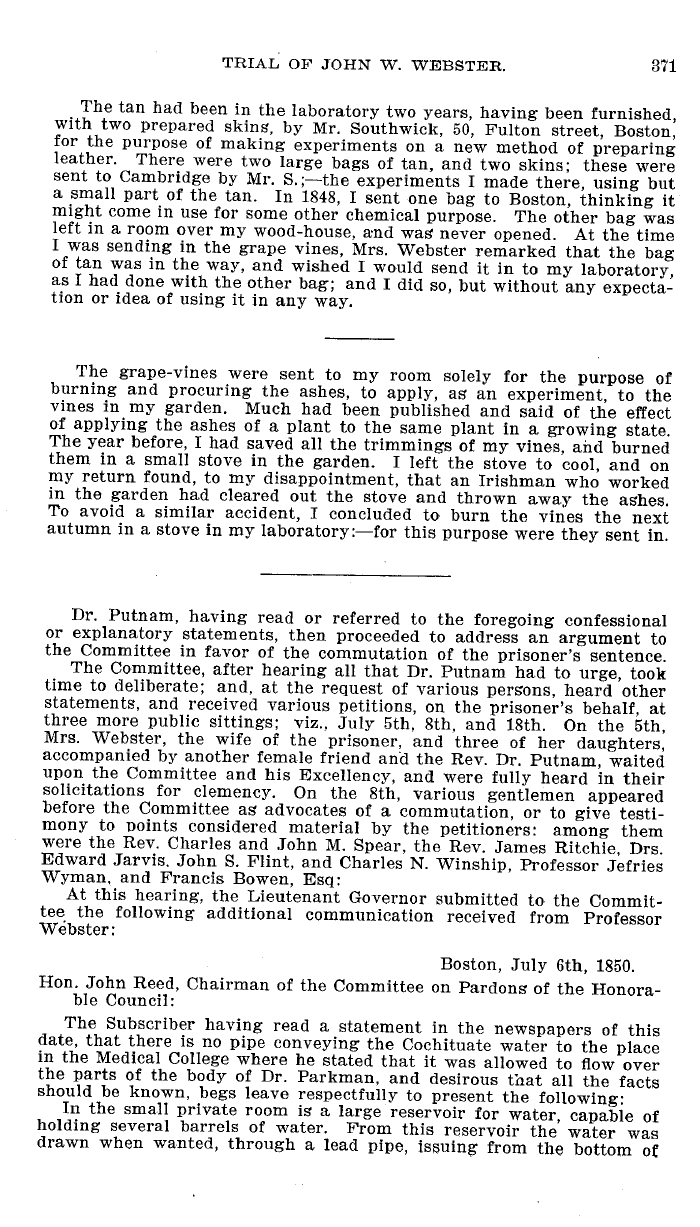|
TRIAL OF JOHN W. WEBSTER. 371
The tan had been in the laboratory two years, having been furnished,
with two prepared skins, by Mr. Southwick, 50, Fulton street, Boston,
for the purpose of making experiments on a new method of preparing
leather. There were two large bags of tan, and two skins; these were
sent to Cambridge by Mr. S.; the experiments I made there, using but
a small part of the tan. In 1848, I sent one bag to Boston, thinking it
might come in use for some other chemical purpose. The other bag was
left in a room over my wood-house, and was never opened. At the time
I was sending in the grape vines Mrs. Webster remarked that the bag
of tan was in the way, and wished I would send it in to my laboratory,
as I had done with the other bag; and I did so, but without any expecta-
tion or idea of using it in any way.
The grape-vines were sent to my room solely for the purpose of
burning and procuring the ashes, to apply, as an experiment, to the
vines in my garden. Much had been published and said of the effect
of applying the ashes of a plant to the same plant in a growing state.
The year before I had saved all the trimmings of my vines, and burned
them in a small stove in the garden. I left the stove to cool, and on
my return found, to my disappointment, that an Irishman who worked
in the garden had cleared out the stove and thrown away the ashes.
To avoid a similar accident, I concluded to burn the vines the next
autumn in a stove in my laboratory:-for this purpose were they sent in.
Dr. Putnam, having read or referred to the foregoing confessional
or explanatory statements, then proceeded to address an argument to
the Committee in favor of the commutation of the prisoner's sentence.
The Committee, after hearing all that Dr. Putnam had to urge, took
time to deliberate; and, at the request of various persons, heard other
statements, and received various petitions, on the prisoner's behalf, at
three more public sittings; viz., July 5th, 8th, and 18th. On the 5th,
Mrs. Webster, the wife of the prisoner, and three of her daughters,
accompanied by another female friend and the Rev. Dr. Putnam, waited
upon the Committee and his Excellency, and were fully heard in their
solicitations for clemency. On the 8th, various gentlemen appeared
before the Committee as advocates of a commutation, or to give testi-
mony to Doints considered material by the petitioners: among them
were the Rev. Charles and John M. Spear, the Rev. James Ritchie, Drs.
Edward Jarvis. John S. Flint, and Charles N. Winship, Professor Jefries
Wyman, and Francis Bowen, Esq:
At this hearing, the Lieutenant Governor submitted to the Commit-
tee the following additional communication received from Professor
Webster:
Boston, July 6th, 1850.
Hon. John Reed, Chairman of the Committee on Pardons of the Honora-
ble Council:
The Subscriber having read a statement in the newspapers of this
date that there is no pipe conveying the Cochituate water to the place
in the Medical College where he stated that it was allowed to flow over
the parts of the body of Dr. Parkman, and desirous that all the facts
should be known, begs leave respectfully to present the following:
In the small private room is a large reservoir for water, capable of
holding several barrels of water. From this reservoir the water was
drawn when wanted, through a lead pipe, issuing from the bottom of
|

